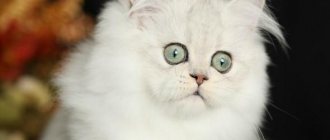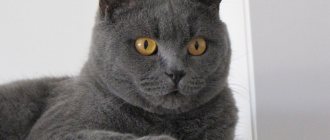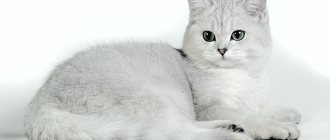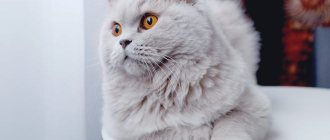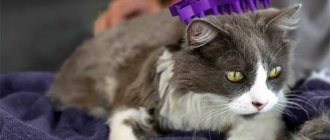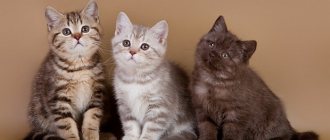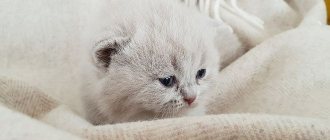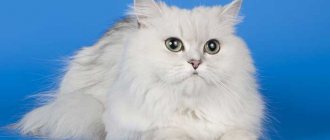Domestic felines with curved ear tips to match the shape of their heads, large expressive eyes, dense builds and plush fur are very popular. This is a British Fold cat. The contradiction can be read already in the very name of the breed. Representatives of the “British” have exclusively erect ears, while the “Scottish” may have floppy ears. It turns out that the breed does not exist. From an official point of view, this is true. But these sweet noble creatures have not left anyone indifferent for more than a decade.
Brief history of the breed
Experts disagree on exactly when the British Fold appeared.
- The first version dates back to the time when the ancient Romans conquered Britain (around 43). Egyptian cats also came along with the invaders, who later adapted to the new climatic conditions.
- Another hypothesis mentions the Crusades - the warriors appreciated the useful abilities of the eastern rat catchers and brought them home.
- Cats infiltrated merchant ships that sailed between the Old Continent and Africa. There were always a lot of mice on ships, and the crew favored small animals that helped get rid of rodents.
What is known for certain is that the first British cats came to the European mainland from North Africa and the Middle East. Further formation of the breed took place under the influence of local conditions: the animals developed thicker hair and developed immunity against diseases common in the area.
How to tell a Brit from a Scot
Portraits of two branches of the same breed - this is how these representatives of the cat family should be viewed. To learn to distinguish the British from the Scots, you will have to study the breed standards.
External differences between the British and Scots
In terms of visual characteristics, cats are very similar to each other:
- Scottish and British fold kittens have a round head and thick cheeks;
- short and wide nose;
- the transition from the forehead to the nose is not very pronounced, but should be distinct;
- stocky, cobby-type build;
- a powerful neck that smoothly transitions into a well-developed chest;
- rectangular body;
- The Scots have a longer tail, while the British have a medium tail, rounded at the end;
- strong legs and rounded paw tips;
- Unlike the Scotsman, the British cat is always straight-eared.
British cats and kittens
In terms of the quality of their fur, there are almost no differences between British cats and Scottish ones. The fur coat of animals is soft, thick, with a texture that is pleasant to the touch.
The most common colors are:
- solid one-color, the hair is dyed in one tone along the entire length;
- tortoiseshell red-black;
- smoky, ticked – the bleached root part smoothly turns into pigmentation;
- bicolor colors with white;
- striped tabby pattern;
- acromelanic mask color-point.
But in the classic representation of color, the British Shorthair still differs from the Scottish breed. The gray-blue color for a British cat is considered traditional, but for a Scot this shade is not provided for by the standard. But the tips of the ears, pressed tightly to the head, do not allow this cat to be confused with other breeds.
Scottish kitten
Scottish Fold
Differences in Personality
The British and Scots are distinguished by character traits:
- The short-haired, straight-eared British dog does not suffer from loneliness; she easily tolerates the absence of owners in the house. Such a cat needs to be raised from early childhood in order to show its superiority. This is not an exceptional quality of the breed, but an evolutionary pattern - all indigenous animals have a developed sense of self-esteem.
- The Scottish Shorthair, unlike the British cat, loves company and does not tolerate loneliness.
This is interesting! The Scottish Straight can sit in the “Buddha pose” - he stretches his hind legs forward and folds his front legs on his stomach.
Other differences between Scottish Scottish and British cats
Scottish differs from the British not only in character:
- Health. Aboriginal Britons have good immunity, although for some reason they are often susceptible to the common cold. But this is the exception that proves the rule. And the Scots have been under the constant supervision of veterinarians since childhood in order to promptly identify signs of osteochondrodysplasia (a disease of the skeletal bones). Although the danger of genetic complications decreased significantly after felinologists decided to reproduce only in the heterozygous model.
- Another significant difference between purebred British and Scottish cats is life expectancy. Strong Britons often live up to the age of 20, and their Scottish “relatives” rarely cross the 15-year mark.
- It is impossible to immediately determine whether a Scottish Fold kitten will have fold ears. All babies are born with normal straight ears. Only after 3 weeks the shape of the shell changes and the tip of the ear bends forward.
This is interesting! The Scottish Scottish loves to rest on its back. His British counterpart is not equipped for such a trick.
Interesting facts about the British cat breed
Descriptions in ancient books and images in paintings indicate that the first British cats were not fold-eared:
- The Gospel from Lindisfarne (7th century) contains an image of a cat that is very similar to the modern Briton.
- The Book of Columba, a recognized handwritten masterpiece of the Irish monks, also contains illustrations of straight-eared cats.
Artists and sculptors depicted them to pay tribute to the beauty and grace of these animals. The monks wrote in poems that the life of hermits becomes more interesting and fun if a cat lives nearby. She was the only pet that was allowed to live on the territory of nunneries.
This is interesting! England became the first country to pass a cat protection law. In 936, the English prince Howell Dda issued a decree prohibiting any violence against these animals.
Description of the British Fold breed: standards, appearance and character of the cat
The breed standard details the characteristics required for the breeding of the British Fold cat.
Dimensions and weight
A strong, medium-sized cat with a dense build. Newborn British Fold kittens weigh from 70 to 130 g. In the first week, body weight increases 1.5 times. Further indicators will depend on the gender of the pet - boys gain weight faster, and girls are traditionally more petite and graceful.
The average weight of an adult British cat is 8 kg, and female cats are usually 2-2.5 kg less. The average height of an animal is 28-35 cm, with cats being approximately 5 cm taller than female cats.
Important! One of the peculiarities of the breed is that the British reach puberty at 2 years of age, but they gain weight before the age of 5.
Anatomical characteristics of the British Fold - what a cat of this breed looks like
British fold cats can be divided into three groups:
- Traditional British Shorthair. The auricles are small, with a slight rounding at the apex. The coat is thick and shiny. Powerful and flexible tail of medium length.
- Long-haired cat. Breeders crossed the British with other breeds (Persians or representatives of the Somali branch) in order to obtain new colors. But in addition to color, the animals inherited long hair from their parents. Such kittens were first culled, and later interbreeding was prohibited. But the population of mestizos increased and was subsequently officially recognized by felinologists as the long-haired British cat.
- Fold-eared Briton. A cat with short, thick hair and ears that curve forward. The body is wide, the paws are low. Some international felinological organizations do not officially recognize the breed because they consider lop ears to be a defect that was caused by a gene mutation.
This is interesting! All newborn kittens of this breed have straight ears, so it is impossible to immediately determine whether the pet will have fold ears.
British coat color and type
The Scottish (or British Fold) breed took from its parent branch a short, thick coat with a dense, elastic texture and a warm undercoat.
Traditional colors include:
- blue lop-eared British;
- gray fold cats;
- tabby tabby cats.
There are about 200 combinations of different colors in the colors of the British Fold cat breed, including the exotic acromelanic color point.
Possible breed defects
An uncontrolled mutation negatively affects the condition of skeletal bones, joints and spine in (Scottish) British fold cats. To counter the deterioration of the genotype, felinologists and breeders had to develop some rules that prevent the development of irreversible defects.
- When crossing, the union of two fold-eared parents is avoided. In a cat “marriage,” a Fold-eared Briton is matched with a cat from a different breed—American Shorthair or Exotic.
- Even as a result of mating with representatives of other breeds, offspring may be born that are predisposed to loss of tail flexibility due to fused vertebrae. For this reason, felinologists cull short-tailed British cats, which are more prone to developing this disease than others.
Geneticists were able to find out how this mutation affects the health of the British Fold cat. It turns out that negative consequences occur only in the presence of a homozygous form, when both acquired genes are present in the same paired state.
Alleles that scientists have already studied are responsible for lop ears. In the FdFd variant, they lead to irreversible consequences, and the Fdfd combination is completely safe for the health of the British Fold cat.
Important! If the cat has signs of lameness, and small kittens avoid active movements such as running and jumping, this is a signal of the presence of a congenital disease.
Colors
The coat of a British cat can be either monochromatic or multi-colored, including 2 or 3 colors.
Plain “British” ones are:
- blue (classic version);
- silver-gray;
- white;
- black;
- brown;
- red;
- peach.
Multi-colored cats are:
- tabby (striped color);
- bicolor (a combination of dark and light colors);
- smoky (each hair is transversely divided into two shades);
- "Siamese";
- "tortoiseshells".
The character and temperament of the British (how they treat children, do they get along with other animals)
The habits of the British Fold cat and its character do not at all correspond to the parent breed:
- The behavior of the British cat is balanced; it does not show aggression towards others.
- A distinctive character trait of the British Fold is devotion to the owner and other family members.
- Despite their sociability, representatives of this breed can easily tolerate loneliness.
- British cats get along well with children and enjoy taking part in general games, but do not like to be treated roughly.
The history of the appearance of true British colors
The main role in the formation of new colors in cats belongs to genetics. The first cats bred without any rules, since the survival of the species was the main goal. But when the cat became a pet and settled next to a person, the situation changed dramatically.
The owners wanted to make some parameters more predictable in order to get kittens with a certain coat color.
Important! Based on the variety of registered colors (more than 200), the British cat ranks one of the first places in the hierarchy of cat breeds. The trademark is solid coat colors.
The gray-blue shade has been recognized as the main color for British Shorthair cats. The further evolution of colors began with him. The main achievements of the debut period are attributed to the English artist Harrison Weir, a great lover of British cats and a specialist who compiled the first standard of this breed.
During the selection, a line of solid colors was fixed, where, in addition to the main one (often called British), a palette of white, black, blue, cream, chocolate and red appeared. And at the end of the twentieth century, a purple tint was added to them.
Important! According to the rules of solid colors, the fur of a lilac British cat must be dyed from root to tip in one even color, without half-tone transitions.
How to choose the right kitten
Felinologists recommend taking purebred animals from the nursery no earlier than they are 3 months old. By this time, British kittens will already get used to eating on their own, learn the rules of personal hygiene and learn the rules of living in the house.
Kitten care
The owner of a British kitten will have to organize comfortable conditions and help the pet get comfortable in a new place. Most likely, you will have to re-accustom him to the scratching post and tray. Caring for British cats in childhood involves regular and proper feeding, as well as compliance with the necessary hygiene procedures.
British Shorthair
When people talk about this breed, it is worth clarifying which one they mean: long-haired or short-haired. The differences are worth looking for between the Scottish Fold and the British Shorthair. These two species are very similar in appearance. The British only have straight ears. Fold is no longer British. Color – blue, black, white, chocolate and red. Rarely – silver with a striped pattern. It is also worth distinguishing between blue and purple coat colors. Comparative table of the British Shorthair and Scottish Fold breeds
| Weight | The male weighs 5-8 kg, the female 3-4 kg. But the weight of castrated and sterilized individuals sometimes significantly exceeds this figure. Due to the peculiarities of metabolism in the body, the male’s weight reaches 10-12 kg, and the female’s weight reaches 7 kg. |
| Size | Medium-sized, very muscular body with a short and thick tail. The tail is rounded at the end. Males grow up to 3 years of age, and cats mature up to a year or even before their first birth. |
| Character | Calm and not very active. She does not experience any particular distress if she does not see her owner for a long time, but she is always happy to welcome him home. Gets along well with dogs and children. By the way, a dog can be excellent company when the owner is away from home. They will not bite or scratch unnecessarily. They are more likely to express their dissatisfaction by simply leaving the room. It’s not for nothing that they are called English aristocrats. |
| Care | The main care for the British cat is brushing once a week and living in clean conditions. |
| Shedding | They shed moderately twice a year, but if you brush them regularly, the shedding will go unnoticed. |
To understand more precisely the differences between these two types, let's look at their parameters in a comparative table.
Leave the content of the British
British cats are short-haired, so they are brushed at least once a week, and every other day during heavy shedding. To care for the fur, use standard “cat” combs or special gloves, which can be purchased at a pet store.
The presence of slight discharge from the eyes and nose is normal for the British Fold cat. The owner needs to regularly carry out hygiene procedures - clean the nose and eye area from dirt.
Particular attention should be paid to cleaning the ears of a British Fold cat. The unusual structure of the shell complicates the procedure, so you need to act very carefully so as not to harm your pet.
- First, the bent tip of the ear is bent and access to the inside is freed.
- Using a cotton swab, carefully clean the areas that are in your field of vision.
- For deeper cleaning, use special ear drops or other preventive liquid preparations that can be injected into the ear canal.
Unusual cat behavior is a cause for concern. If your pet shakes its head or there is an unpleasant odor coming from the ear, you should immediately seek help from a veterinarian.
Feeding a British Fold cat
The diet depends on the individual characteristics of the cat. The pet owner must choose one of three options:
- natural food;
- industrial feed;
- mixed feeding.
Practice shows that in real life all three points are used. During childhood, owners and breeders most often feed British Folds with homemade food and independently calculate the portion and calorie content.
Adult cats switch to dry kibble without any problems. And in old age, the animal happily eats both the first and the second.
Important! Representatives of this breed are prone to overeating and gaining excess weight. This is dangerous for the cat's health, since it has a genetic predisposition to diseases of the bones and joints.
Description of character
Despite the differences between the British Fold and his ancestors from essentially different breeds, he took the best - incredible friendliness and affection for his owners, balanced disposition and calmness. He loves games, but he never imposes himself, and is also easy to basic training.
To get an obedient pet with a gentle disposition, the owner is required to give up unreasonable aggression and rudeness towards him.
"Lop-eared" becomes attached to the owner
This cat loves to eat, which may be why she quickly becomes attached to the person who feeds her. Therefore, it is advisable that the owner himself does this if he wants to receive devotion and obedience in response to care and affection.
Such a pet is independent and self-sufficient, and is considered an ideal option for a person who is busy at work for a long time.
So, he can remain alone for a long time, but he will always happily meet the person to whom he is attached.
In addition, the cat loves to just sit next to the owner or work with a claw sharpener, and if necessary, he will easily support the game he has started. But at the same time he never sits in his arms and does not tolerate hugs.
Temperament
Like the Scottish Fold, the British Fold is very inquisitive and gentle. Therefore, the maximum that you can get from him in case of dissatisfaction is a loud cry and a dissatisfied look.
It is also worth remembering that a long flexible tail is a pet’s special pride, and, in his opinion, always requires careful handling.
The British is clean and always looks respectable, which should also be remembered. That is, you need to be prepared for the fact that it will require constant attention from a person.
He is very independent and independent, requires personal space and respect from people. Without receiving anything, he will begin to show his dissatisfaction, which will lead to problems in mutual understanding.
In general, a cat can be either calm and balanced, or active and restless, which manifests itself in each individual case in its own way.
Pride in such a representative of the family can be combined with playfulness, and gentleness of character with an interest in hunting and tracking down the intended prey.
Relationships with other household members (children and dogs)
The behavior of the Fold remains friendly to everyone; he does not perceive aggression from the outside and does not show it himself. He gets along well with dogs and other pets. He dotes on children, playing with babies and cuddling with them for hours or falling asleep next to the child. Also read the article about the best cat breeds for children.
The main rule here is not to touch the tail and not to offend it in general, otherwise the cat will simply run away, maybe even leave the house.
In some cases, teeth and claws can be used against adults, but such a negative attitude will manifest itself immediately, because they do not know how to harbor a grudge. We recommend reading the article about breeds prone to aggression.
Education and physical activity
Despite their sociability, the British are independent and willful. Therefore, when training and raising a pet, certain rules should be followed:
- You need to show your cat your dissatisfaction immediately after committing an offense.
- It is important to maintain consistency in the training process - for example, you should not allow your pet to sharpen its claws on the back of a chair today, and scold your pet for it tomorrow.
- Praise is very important for the British Fold - do not forget to reward the cat for positive actions.
Physical activity is one of the main indicators of an animal’s quality of life. It is necessary to provide the animal with sufficient space for play, prepare toys and be sure to engage with it.
Vaccinations and antiparasitic treatments
A standard scheme for the prevention of internal and external parasites (endo- and ectoparasites) is applied to British cats.
Before a kitten goes to a new owner, the nursery must carry out deworming and flea treatment. In the future, preventive measures are carried out according to the following scheme:
For lop-eared Brits who don't go outside:
- Treatment against external parasites using drops or in combination with a special collar – once a month.
- Antihelminthic procedures are carried out once every 6 months, in the first week after treatment against ectoparasites.
Cats that go outside are dewormed and treated for external parasites 2 times more often.
Important! You can become infected with worms and fleas even in an apartment - the larvae are brought into the room with shoes or clothes.
Scottish fold cat (Scottish fold)
Kittens are blue (ashy) in most cases. However, according to world standards, the color of their coat can be very diverse: white, black, striped, chocolate. Externally they are small, on high massive legs. This breed is distinguished from others by its ears, which are pressed to the head. They should look down and forward at the same time, creating a single whole in the outline of the head. There are one to two folds on the ears. The more there are, the more they are pressed against the head and acquire the correct shape.
| Weight | From 4 to 7 kg |
| Size | The body is medium, not stretched |
| Character | She becomes attached to one person in the family more, but will never be obsessive in her behavior. The Scot would rather purr next to you than climb into your arms. He gets along easily with dogs, and they will be good company for him if the owner is not at home. Representatives of the Scottish Fold rarely show their claws and growl, but in the right situation they can stand up for themselves. They love children very much. |
| Playfulness | Cats spend most of their time sleeping, but they also love to play. The state of the game does not reach the point of fatigue. They seem to say, after playing a little, “That’s it, that’s enough. Good things come in small packages". But this does not apply to kittens. |
| Care | Scots need to have their ears cleaned regularly as wax accumulates in the fold, but you should not try to loosen the fold. Wool is not picky about care. Brush it 1-2 times a week and that will be enough. |
| Shedding | The period of coat change is spring, autumn. But living at home can change everything. They shed moderately. |
Sterilization and castration
In order not to deteriorate the breed, experts recommend spaying/castrating cats with minor or critical defects. Not everyone knows that sterilization and castration of animals are two different procedures, and cats are also castrated.
- Sterilization does not involve the removal of organs, but only limits their reproductive functions. It is considered more gentle and humane towards animals. However, after sterilization, the behavior of cats does not change. They still have a natural desire to mate, but are physically unable to produce offspring.
- Castration is carried out on both male and female cats. As a result of surgery, the testes (for males) and ovaries (for females) are removed. The production of sex hormones stops, reproductive function is absent.
Hidden dangers of surgical procedures exist, but such operations are always planned and have already become familiar to veterinarians.
Pros and cons of the British cat breed
| Positive traits | Negative qualities |
| Unusual appearance | Tendency to genetic diseases |
| Sociability and loyalty to all family members | Ears require special care |
| Good learning ability | |
| Resistance to common diseases |
Experts believe that it is already possible to detect the presence of genetic diseases in a British Fold cat at the age of 3-5 months. In addition, conscientious breeders adhere to recommendations regarding mating in order to improve and strengthen the breed.
In such conditions, the risk of developing pathologies is reduced to a minimum, which means that the risk of acquiring a sick animal is significantly reduced. A healthy and cheerful fold-eared cat is always joy and good mood for its owner.


